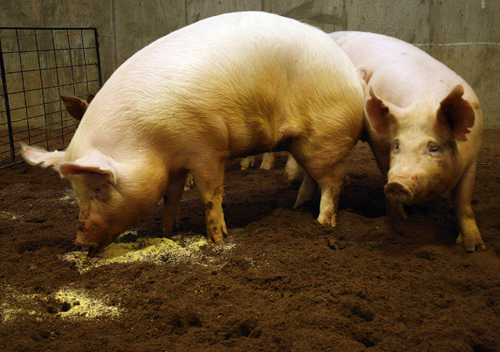ATHENS – Two University of Georgia animal science researchers introduced to the world 13 pigs that may hold the key to new therapies to treat human diseases, including diabetes. Announced this week, the discovery marks the first time pluripotent stem cells, or cells that can turn into any type of cell in the body, have been created from adult livestock.
“We now for the first time have a method to make pigs that can be a source of cells and organs for regenerative medicine in a meaningful way” said Steven L. Stice, a Georgia Research Alliance eminent scholar in the UGA College of Agricultural and Environmental Sciences. He also directs UGA’s Regenerative Bioscience Center. The technique called induced pluripotent stem cells had only previously been shown to make live offspring in mice.
“These first-in-the-world, pig-induced pluripotent cells-generated animals can eventually be used to provide and search for better therapies and cures for human disease and degenerative conditions,” Stice said. The discovery is a new tool for researchers who need to determine which sources of cells, adult or earlier stages such as embryonic or induced pluripotent stem cells, will work best for each disease.
Better source of cells, organs
The induced pluripotent stem cells piglets were born in September 2009 at Wisconsin-based company Minitube of America, Inc., according to project collaborator John R. Dobrinsky. Minitube is a biotechnology company specializing in artificial reproduction biotechnologies and cell biology.
The process used avoids the more problematic and controversial cloning process while making it easier to make the genetic changes necessary to develop pigs as a better source of cells and organs for transplantation. “Although induced pluripotent stem cell technology was first successful in mice, the mouse isn’t always a good model to study human disease and they are not a good source of tissue and organs for therapy,” Stice said. “Pigs are often the best way to go.”
Pigs are biologically and physiologically very similar to humans and are prone to develop many of the same health problems as humans, Dobrinsky said.
Stice credits Franklin West, an assistant research scientist, with perfecting the method. “I’ve worked on this for about 20 years,” Stice said. “Franklin found the way to make it work.”
The pluripotent stem cells incorporated naturally into the developing fetuses and contributed to the development of many cell types of the body, such as lungs, kidney, heart, skin or muscle, producing healthy piglets, West said. And 80 percent of the animals produced using this new method are a product of these stem cells, a very high percentage.
This cellular experiment demonstrates proof of concept by injecting pig-induced pluripotent cells into early pig embryos, Dobrinsky said.
Type I diabetes treatment
The new process will be valuable for a research project underway in partnership with Emory University to find better therapies for diabetes.
“Islets that produce insulin and other hormones related to regulating blood sugar are found in the pancreas,” Stice explained. “It is well known that porcine islet cells could be a major break through in the treatment of Type I (juvenile) diabetes if they were not rejected by the human immune system. This new method will allow researchers to make the necessary genetic changes to dampen or potentially eliminate the rejection of the new stem cells and then we can make animals from these stem cells.”
Economic, environmental impacts
Another goal, Stice said, is for the study results to lead the way to healthier, more environmentally friendly and disease-resistant livestock, and ones that could help reduce poverty or starvation in developing countries.
Once the new pigs reach sexual maturity and Stice and West determine if the pigs produce viable sperm and egg cells, they can begin naturally mating. The offspring of the current pigs will produce the cells needed to move into the therapy stage and clinical trials.
Details of the discovery will be published in the journal Stem Cells and Development next month.













